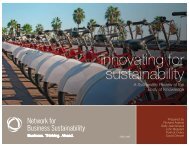embedding sustainability in organizational culture - Network for ...
embedding sustainability in organizational culture - Network for ...
embedding sustainability in organizational culture - Network for ...
Create successful ePaper yourself
Turn your PDF publications into a flip-book with our unique Google optimized e-Paper software.
Chapter 1: 6: Introduction Instill<strong>in</strong>g Capacity <strong>for</strong> Change<br />
48<br />
learn<br />
The practices <strong>in</strong> this category focus on creat<strong>in</strong>g processes and mechanisms to gather<br />
knowledge or skills related to <strong>susta<strong>in</strong>ability</strong>. The practices exam<strong>in</strong>ed here <strong>in</strong>clude<br />
scann<strong>in</strong>g; benchmark<strong>in</strong>g; conduct<strong>in</strong>g pilot projects; learn<strong>in</strong>g from failure and<br />
reflect<strong>in</strong>g.<br />
Scan: Make use of systems or processes to perceive and recognize external<br />
<strong>in</strong><strong>for</strong>mation<br />
• Attend <strong>in</strong>dustry and environmental conferences<br />
• Jo<strong>in</strong> a <strong>susta<strong>in</strong>ability</strong> organization where members share <strong>in</strong><strong>for</strong>mation<br />
and best practices<br />
• Observe competitors’ <strong>susta<strong>in</strong>ability</strong> activity<br />
• Scan multiple sources habitually<br />
• Develop many diverse <strong>in</strong>ternal and external knowledge and<br />
opportunity networks<br />
• Research stakeholder needs and values<br />
• Scan <strong>for</strong> changes <strong>in</strong> legislation and upcom<strong>in</strong>g regulatory<br />
requirements<br />
• Use focus groups and surveys to garner customer op<strong>in</strong>ions on<br />
<strong>susta<strong>in</strong>ability</strong> issues<br />
• Subscribe to newsletters or periodicals on <strong>susta<strong>in</strong>ability</strong> issues<br />
In a rapidly chang<strong>in</strong>g environment, organizations must be constantly and<br />
proactively look<strong>in</strong>g <strong>for</strong> opportunities and threats. Scann<strong>in</strong>g entails cont<strong>in</strong>uously<br />
look<strong>in</strong>g out <strong>for</strong> <strong>susta<strong>in</strong>ability</strong> opportunities. Scann<strong>in</strong>g also <strong>in</strong>volves research<strong>in</strong>g all<br />
available sources <strong>for</strong> the latest <strong>in</strong><strong>for</strong>mation and expert op<strong>in</strong>ions on <strong>susta<strong>in</strong>ability</strong>,<br />
and hav<strong>in</strong>g a f<strong>in</strong>ger on the pulse of the <strong>susta<strong>in</strong>ability</strong> landscape.<br />
Organizations should encourage employees to keep themselves up to date on<br />
<strong>susta<strong>in</strong>ability</strong> by access<strong>in</strong>g onl<strong>in</strong>e <strong>in</strong><strong>for</strong>mation, read<strong>in</strong>g books, and talk<strong>in</strong>g with<br />
experts to identify ways that the organization can change (Doppelt, 2008). One CEO<br />
likened scann<strong>in</strong>g to hav<strong>in</strong>g opportunistic antennae (Dixon & Clif<strong>for</strong>d, 2007).<br />
Anderson and Bateman (2000) found that successful champions scanned their<br />
environment, collect<strong>in</strong>g <strong>in</strong><strong>for</strong>mation from <strong>in</strong>dustry and environmental conferences<br />
and, to a lesser extent, environmental consultants and competitors. Colbert and<br />
Kurucz (2007) note that habitually search<strong>in</strong>g <strong>for</strong> new <strong>in</strong><strong>for</strong>mation needs to become<br />
culturally embedded <strong>in</strong> the organization so that it moves from be<strong>in</strong>g an <strong>in</strong>dividual<br />
capability to an <strong>organizational</strong> one. One organization <strong>in</strong> Maon and colleagues’<br />
(2009) study rout<strong>in</strong>ely asks its stakeholders their op<strong>in</strong>ions about its values<br />
and planned activities, which allows it to adjust and adapt if required. Lead<strong>in</strong>g<br />
organizations balance their <strong>in</strong>ternal and external focus, and build and ma<strong>in</strong>ta<strong>in</strong><br />
extensive l<strong>in</strong>ks beyond their sector or <strong>in</strong>dustry to keep up to date with the latest<br />
practices and new developments (Molnar & Mulvihill, 2003).<br />
Although our knowledge on this practice is develop<strong>in</strong>g, further empirical work is<br />
required to understand how scann<strong>in</strong>g can be best employed to support a <strong>culture</strong> of<br />
<strong>susta<strong>in</strong>ability</strong>.<br />
assessment: Weakly supported<br />
BEnchMaRk: compare your bus<strong>in</strong>ess processes and per<strong>for</strong>mance to<br />
<strong>in</strong>dustry-bests and/ or best practices from other <strong>in</strong>dustries<br />
• Select <strong>organizational</strong> <strong>susta<strong>in</strong>ability</strong> metrics that are used by others<br />
to facilitate benchmark<strong>in</strong>g<br />
• Decide which <strong>in</strong><strong>for</strong>mation should be made public so that the<br />
organization’s per<strong>for</strong>mance can be transparently compared to that of<br />
other organizations<br />
• Consider benchmark<strong>in</strong>g <strong>in</strong>ternally between divisions, bus<strong>in</strong>ess units<br />
or locations<br />
Benchmark<strong>in</strong>g facilitates learn<strong>in</strong>g by situat<strong>in</strong>g an organization’s per<strong>for</strong>mance<br />
relative to others. Organizations may f<strong>in</strong>d that they lead or lag the ef<strong>for</strong>ts and<br />
achievements of other organizations and can get a sense of ‘best practices’ by<br />
compar<strong>in</strong>g their per<strong>for</strong>mance to others (Blackburn, 2007).<br />
Safety per<strong>for</strong>mance is one area where many companies openly benchmark their<br />
per<strong>for</strong>mance and where statistics can be readily compared. By contrast, Blackburn<br />
(2007) notes many other <strong>susta<strong>in</strong>ability</strong> metrics are difficult to compare across<br />
companies and especially across <strong>in</strong>dustries. When first embark<strong>in</strong>g on benchmark<strong>in</strong>g,<br />
see if there are exist<strong>in</strong>g metrics that can be adapted to the organization’s purposes<br />
(NBS, 2010). Br<strong>in</strong>k and van der Woerd (2004) suggest that benchmarks allow<br />
management to better measure and manage corporate responsibility. Goodman<br />
(2000) found that <strong>in</strong>ternal benchmark<strong>in</strong>g helped divisions set realistic targets by<br />
see<strong>in</strong>g how well their peers were do<strong>in</strong>g.
















